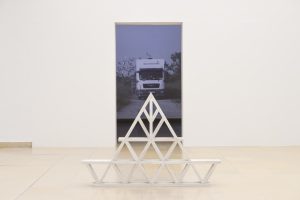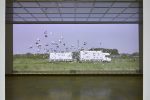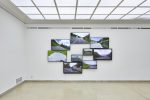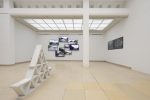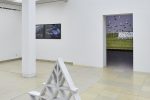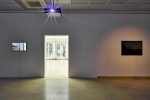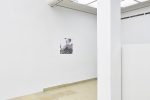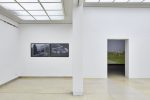Voyageurs
Sofia Dona
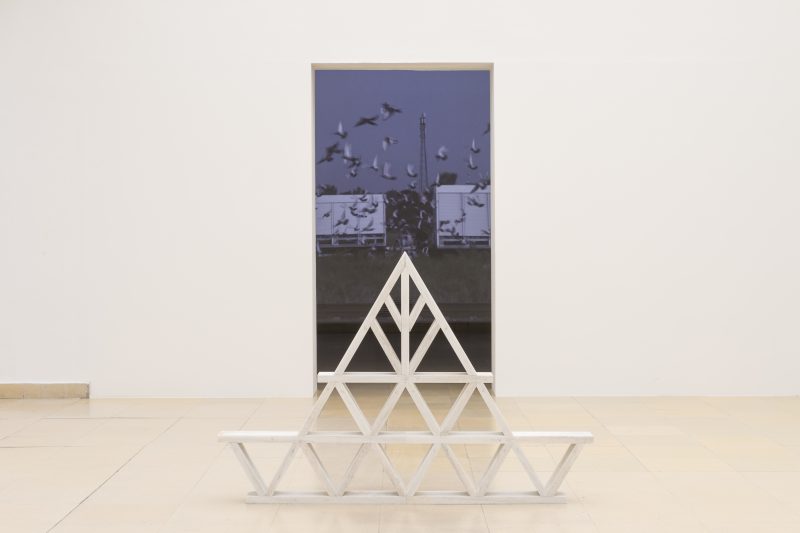
In her exhibition Voyageurs Sofia Dona explores physical, geographical and environmental landscapes in order to reconnect them with social and political ones. Bird flights, border crossings, alternative paths through mountains and highways are presented with the aim of providing a different understanding of arrivals, deportations and forced journeys.
When entering the Kunstpavillon, a truck or a swarm of doves appear to come towards one in the central viewing axis. The path to the video work filling the rear area is blocked by a sculptural intervention constructed like a house of cards from white marble slabs.
In her exhibition Voyageurs, Greek artist and architect Sofia Dona, trained in Athens and Weimar, examines physical, geographical and ecological landscapes in order to link them to the social and the political. The video installation of the same name shows a truck standing in the middle of flat country; soon 3,000 pigeons rise into the air from both sides of its loading area. Played in slow motion, the moment of release is extended, even celebrated. The birds are homing pigeons–one breed actually bears the name “voyageurs”, travellers–, which are often released hundreds of kilometres away from their lofts and whose owners, mostly older men, wait at home for the animals to return. The ability to find home is amazing: like migratory birds, the pigeons orient themselves according to the earth’s magnetic field. They are only able to return to the place where they were raised. National borders are often crossed in pigeon racing, but mountains and the sea cannot be found on the racing circuits. The risk of losing a lot of birds would be too high considering their price and the starting fees for races. The video was taken near the German-Polish border town of Tantow. The destination of the homing pigeons is Hamburg, about 290 km away as the crow flies. On a small screen, the work Racing Homers can also be seen in the darkened back area. In close-up and even more slowly than in Voyageurs, pigeons can be seen leaving the special truck. Under their wings some of the birds have coloured markings, so that the owners can recognize them as theirs from a distance. The sound produced by the flapping of the birds’ wings is almost like an explosion. The “Racing Homer” is a modern racing pigeon breed that arrives home especially quickly. The fact that the ancient poet Homer–to whom the Odyssey, the famous story of Odysseus’ travels is attributed–appears in the breed’s name is an association that Sofia Dona picks up and at the same time, this clarifies her approach: a combination of scientific research and personal experience and ideas, as well as opening up metaphorical levels. The black-and-white photograph Bird Traps, which the artist took on the small Greek island of Mathraki and which is presented in semi-darkness along with Voyagers and Racing Homers, also indicates this method. The dramatic ambivalence of the nets stretched between trees, without the knowledge that the island is inhabited by only 30 people and looks back on a long history of emigration, is immediately perceptible to the viewers.
The abstract, almost modernist seeming marble structure entitled Pigeon House in the entrance area closes or opens the narrative around the birds that were formerly bred as farm animals and are mainly used for leisure purposes today. On the Cyclades island of Tinos, pigeons have been bred since the 13th century–on the one hand for their meat, and on the other because their excrement is used as a fertilizer. About 1000 pigeon houses, built in the 18th and 19th centuries, are still preserved. The typical triangular entrances and exits to the nests mean that they constitute an architectural peculiarity. Since marble is also mined on Tinos and the marble experts and craftsmen are widely known, the artist created Pigeon House together with a sculptor on Tinos.
Less poetic, indeed reminiscent of a video game, is the installation Alternative Brennero in the side wing of the exhibition space. On nine different monitors arranged in a cloud formation, it shows films of private individuals crossing the Alps on motorcycles, the footage having been found on YouTube. What the amateurs record with cameras mounted on helmets or handlebars and share on the Net, in part accompanied by music, are documents of pure driving pleasure. Pass roads are “conquered” without being tied to a specific purpose. The weather does not always play along. The title Alternative Brennero is borrowed from the lead story of an article in a tourist magazine reporting on particularly beautiful routes and north-south connections off the main Brenner route. The fact that the Brenner is not an alternative for everyone, especially not for those fleeing from the south to the north, quickly springs to mind and resonates in the title as much as the transit issue.
A black-and-white photograph in the same area of the Kunstpavillon is an enlargement of an historical photograph of today’s A8 motorway from Munich, southbound to the Austrian border. Faux Plat is what Sofia Dona calls the blow-up of a photo from the archive of landscape architect Alwin Seifert, who planned the so-called “Reichsautobahn” during the Nazi era. “Faux-plat” (French: slightly ascending) is a technical term in landscape architecture that describes a trick used to make a gradient appear flat, for example by using elongated curves. The former Reichsautobahn nestles, gently curving, into the Bavarian foothills of the Alps and does not take the direct route over long stretches–not only to prevent excessive steepness. It was a matter of aesthetic considerations–a picturesque view of the Alps could and still can be assured in this way.
As in the mural work Liberations and Arrivals, in which Sofia Dona traces the flight paths of the Central European competitions run in July 2019 by the pigeon racing federation P.I.P.A. (Pigeon Paradise) using nails and taut threads, the narratives often merely suggested and thus evoked in the imagination of the recipients of Voyageurs condense into a dense net. Bird flights, border crossings, alternative routes over mountains and motorways are presented in order to convey a different understanding of arrival, deportation and (in)voluntary travel.
Ingeborg Erhart
Premierentage – Wege zu Kunst, Saturday, November 9, 2019
Finissage from 11.00 – 17.00
Artist Talk at 13.00 with Andrei Siclodi
Duration of the exhibition: September 6 – November 9, 2019
Opening hours: Wed – Fri 11 a.m. – 6 p.m., Sat 11 a.m. – 3 p.m., closed on holidays
Guided tours on Saturdays at 11 a.m. and 2 p.m.
Dates: 14.09. und 12.10. 2019
Thanks to: Anastasios Christodoulou, Stella Chronopoulou, Isidora Harbila, Claudia Nikos Karamanlis, Kyriacos Karseras, Elsa Kiourtsoglou, Leonidas Kourmadas, John Nikolopoulos PIPA (Pigeons Paradise), Thalia Raftopoulou, Mathieu Wellner, Claudia Wroński
